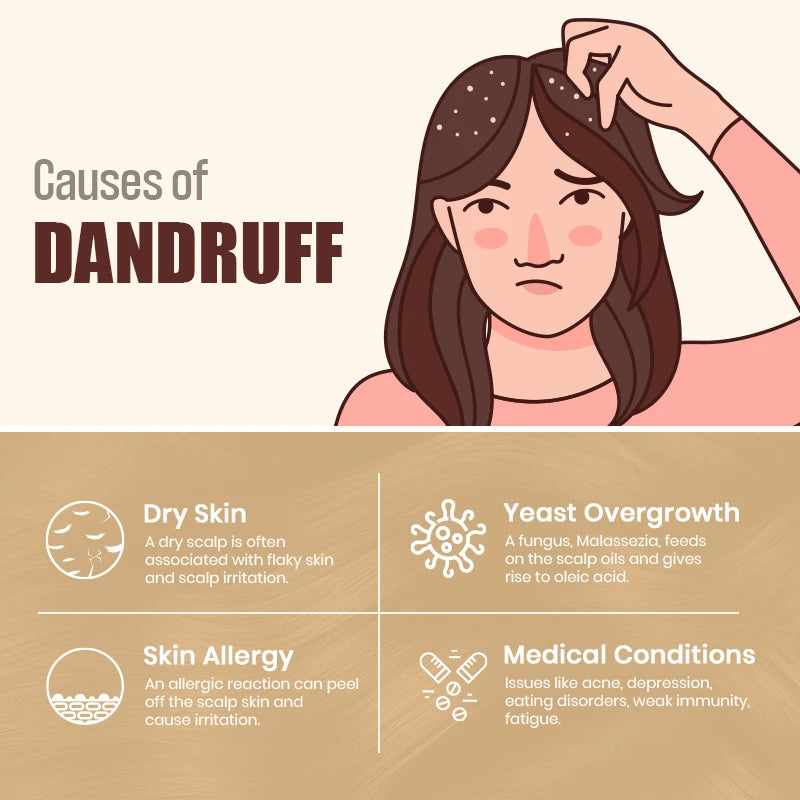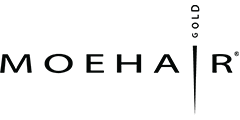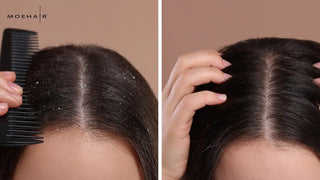 Table of contents
Table of contents
Dandruff is a common condition characterized by flakiness and itchy scalp. It is primarily caused by the Malassezia Globosa fungus. Poor hygiene or excessive oil buildup on the scalp feeds this fungus, leading to white or gray flakes. According to NCBI, it peaks during three age periods — in the first three months of life, during puberty, and in adulthood, with an apex at 40 to 60 years of age. It impacts almost half of American adults, so finding the best way to stop dandruff becomes essential.
Dandruff isn’t contagious, but noticing white flakes on your shoulder can be embarrassing. Too much oil (sebum) in the scalp can lead to this condition. However, its exact cause remains unknown. Before we discuss dandruff removal tips, let’s understand its suspected causes. Here are some reasons why you might be facing flakes and scalp itching.
- Dry Skin - A dry scalp is often associated with flaky skin and scalp irritation. It is common in people who wash their hair frequently. Dr. Kwon told Henry Ford Health, “If dry skin is causing your dandruff, it’s easier to tell as other places of your body are most likely dry as well.”
- Yeast Overgrowth - A fungus, Malassezia, feeds on the scalp oils and gives rise to oleic acid. If you have an oily scalp, the yeast-like fungus can stay up there and trigger an immune response leading to irritation and telltale flakes.
- Skin Allergy - An allergic reaction can peel off the scalp skin and cause irritation. One may be allergic to some ingredients in hair care products used regularly. Stop using products that negatively impact your scalp and opt for medical consultation.
- Medical Conditions - Issues like acne, depression, eating disorders, weak immunity, fatigue, and HIV might trigger dandruff. Thus, dandruff removal tips vary depending on the condition concerned.

So, what exactly is your irritated scalp trying to tell you? Primarily, look out for signs of dandruff, including white or yellow flakes on the scalp, hair, and shoulders, scalp irritation, excessive oil or greasiness, etc. Read on to discover dandruff removal tips suggested by dermatologists for healthy scalp and hair health.
Use an anti-dandruff shampoo
An anti-dandruff shampoo is the first thing anyone and everyone would recommend to fight flaking, inflammation, and irritation. It is one of the best tips for dandruff removal. It removes excess scalp oil and controls dead skin cells, keeping the scalp clean and healthy. And not everybody needs to go to a doctor to get a prescription for these products. Most anti-dandruff shampoos are available in pharmacies and supermarkets as over-the-counter treatments. Watch out for any one of the following active ingredients in the shampoo.
Read more - How to Use Anti Dandruff Shampoo- Ketoconazole - Controls the growth of fungus and yeast on the scalp
- Selenium Sulfide - Removes dry, scaly flakes and eases scalp irritation
- Coal Tar - Inhibits antifungal and anti-itch properties to control dandruff
- Salicylic Acid - Hydrates the scalp and tames greasiness
- Zinc Pyrithione - Inactivates iron-sulfur proteins to hinder the growth of fungus
Opt for tea tree oil treatments
Known for its antifungal properties, tea tree oil inhibits the growth of fungus that causes dandruff. It helps in getting rid of greasiness and itchy scalp. It is one of the natural dandruff removal tips. Not only does it prevent unwanted buildup on the scalp, but it also acts as a natural conditioner that deeply hydrates and nourishes the mane.
- Dilute a few drops of tea tree oil in a carrier like jojoba oil.
- Massage the mixture to your scalp.
- Let it sit for at least 30 minutes or overnight.
- Shampoo your hair as usual.
- Repeat 2-3 times a week, depending on your hair type.
Hydrate your scalp and hair
It is always a good idea to moisturize your scalp to combat dryness and related issues. If you face flaky scalp and irritation due to dryness, look no further than hydrating masks. Consider at-home dandruff removal tips like preparing a scalp mask at home using natural ingredients. It can help control skin irritation and peeling. Here’s a simple DIY recipe with steps to follow:
- Mix coconut oil, honey, and tea tree oil. Stir well.
- Part your hair and apply the mask directly to your scalp. Use your fingertips or a hair dye brush to spread the mask evenly across your scalp.
- Gently massage for a few minutes to ensure it is well-absorbed.
- After the desired time, wash your hair with a gentle shampoo to remove the mask. Make sure to rinse off thoroughly to avoid any residue.
- Optionally, you can follow up with a conditioner to keep your hair soft and hydrated.
- Use the scalp mask 1-2 times a week to alleviate dandruff caused by dryness and promote a healthier scalp.
Go for home remedies
Put your hands up if reaching out to a dermatologist or following a strict medicated routine seems daunting. In that case, one can indulge in easy home remedies. Just like we made a DIY scalp mask, you can root for the following tips for dandruff removal at home.
- Baking Soda - Mix it with water to form a paste, massage it to your damp scalp for a few minutes, then rinse off thoroughly.
- Aloe Vera - Apply freshly extracted aloe vera directly to your scalp and leave it on for 30 minutes. Rinse off thoroughly with water.
- Apple Cider Vinegar - Dilute it with water in a 1:1 ratio and apply the mixture to the scalp after shampooing. Leave it on for some time, then rinse off.
- Natural Juice - Apply freshly squeezed lemon juice to your scalp, leave it on for the desired time, and rinse out with water.
- Egg White - Use egg white as a nourishing scalp mask once or twice a week. Apply and massage it to your scalp. Let it work for 20-30 minutes, then rinse off with water. Follow up with a gentle shampoo.
Talk to your doctor
Plenty of dandruff removal tips are available online. What works for you may not work for others. Thus, it becomes crucial to know the exact cause of your condition. Amidst this, seeking professional help is the best way to stop dandruff when you’ve tried everything else. Determining the root cause of dandruff, your doctor can suggest specialized hair care products, probiotics, and other medications.
FAQs
Q1. How often should I wash my hair to control dandruff?
One must wash hair 2-3 times a week, depending on the hair volume and length.
Q2. Are there any dietary changes or supplements that can help fight dandruff?
Eating a well-balanced diet rich in vitamins, minerals, proteins, and probiotics is recommended.
Q3. Do at-home dandruff removal tips really work?
Yes, numerous home remedies for dandruff actually work. You must be consistent and opt for the trial-and-error process, identifying what works best.
Q4. Do clarifying shampoos help with dandruff?
Anti-dandruff shampoos containing ketoconazole, coal tar, or other effective ingredients help control dandruff. Whereas most clarifying shampoos are meant for only deep cleansing and preparing for chemical treatments.
Q5. How can I get rid of dandruff fast?
Consider anti-dandruff shampoos to clear off dandruff effectively. The most common dandruff removal tips include the use of probiotics, scalp nourishment masks, and OTC products. If none works for you, look out for professional help.
References:
https://www.ncbi.nlm.nih.gov/pmc/articles/PMC4852869/https://www.henryford.com/blog/2016/11/5-causes-dandruff-treat
https://www.researchgate.net/publication/23707824_Seborrheic_Dermatitis_-_An_Early_and_Common_Skin_Manifestation_in_HIV_Patients
How we reviewed this article:
Our experts continually monitor the fashion and beauty space, and we update our articles when new information becomes available.
-
Current Version
-
March 19, 2024
Written By -
Upasana Kakati is a lifestyle writer with 7+ years of experience in writing in the beauty and haircare industry.
Edited By -
Saima Ahmed with 8+ yrs of experience, specializes in crafting engaging content focused on Hair care, lifestyle, and beauty.






















